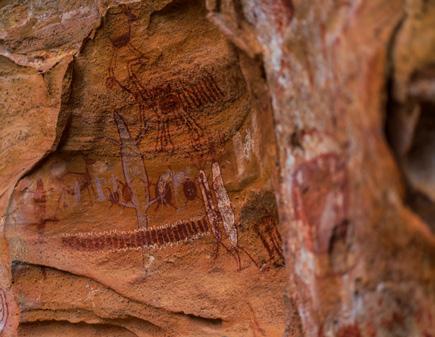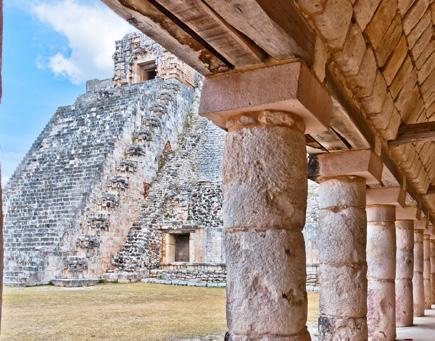TOURS OF A LIFETIME






We are pleased to present our exciting Tours of a Lifetime collection for 2025, featuring four unforgettable adventures to the Americas. Choose to make 2025 the year of exploration and discover remote landscapes, storied monuments, incredible wildlife, bustling cities and so much more in the company of like-minded travellers.
Venture into the lush jungle and learn more about ancient civilisations in Guatemala, Honduras and Belize, journey amongst the sandstone cliffs and rocky canyons of Brazil’s Serra da Capivara to uncover one of the most significant archaeological sites in the world, head to the iconic Easter Island to experience places seldom visited by tourists or take an in-depth tour of Mexico, spanning the fascinating museums of Mexico City to the mysteries of the tropical Yucatán Peninsula.
As always, our prices include everything, from the essentials to site donations, tips to drivers, local guides and hospitality staff plus most, if not all, meals as standard – with wine often included too. You can also expect expert Guide Lecturers on these tours, who lead you through spectacular sites, focusing on the detailed indicators of the past, explaining how things work and what a miracle of human ingenuity they represent.
Wherever you choose to explore, look forward to ticking off a few more items off on your bucket list; walk among Tikal’s magnificent ancient temples and climb their steps as the sun rises over the horizon, examine a remarkable assemblage of prehistoric art depicting wild animals, human figures skirmishing, dancing and hunting, travel back to an ancient world at the awe-inspiring city of Chichén Itzá or traverse the striking Atacama Desert, declared the world’s driest by NASA.
A memorable time away, new experiences and one-of-a-kind discoveries to treasure await.
We look forward to seeing you next year.
Happy browsing!
If you are interested in joining one of our tours and want to know more, please do give our Specialist Travel Executives a call today. They are ready to help with all of your questions.
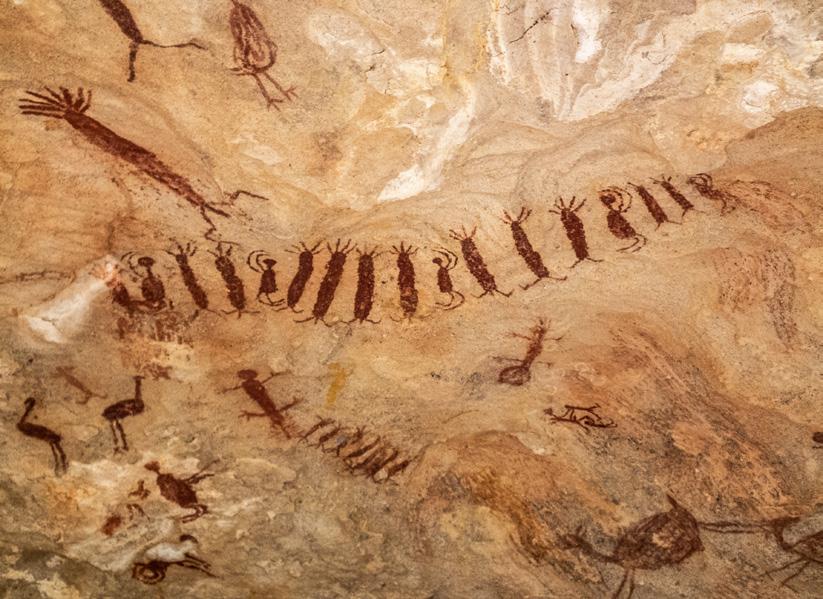
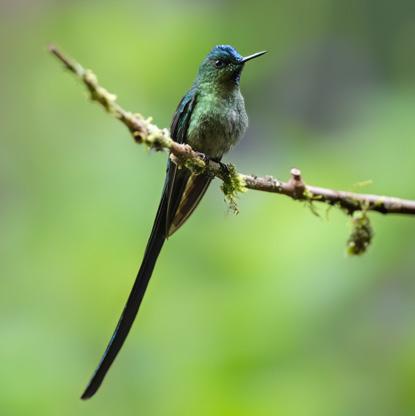
Unearth history's treasures with Andante, the pioneering British specialist on in-depth archaeological travels. Venturing beyond mere cultural excursions, we craft extraordinary journeys, granting you access to the world's most significant historical sites. With 24-hour support from our dedicated team and meticulously planned itineraries, rely on Andante for an unparalleled odyssey into antiquity.
“
This is the first time I have travelled with Andante and it was exceptionally good! One thing that surprised me was the impact of spending a week with people who had worked together for so many years…That easy familiarity was very, very special.
”
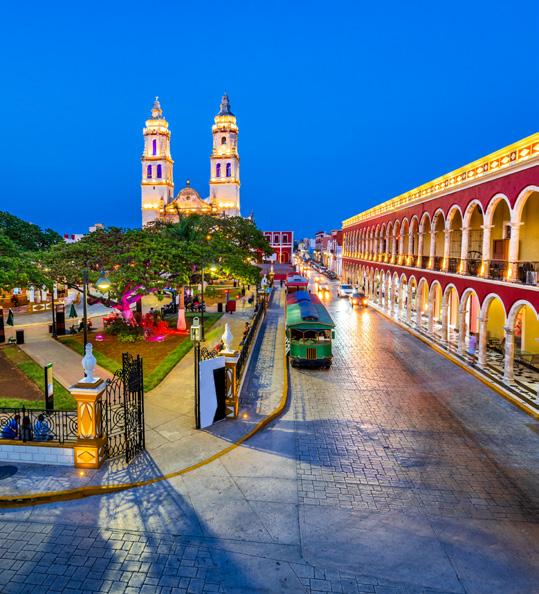
• We keep it small with a maximum group size of 18
• We take you to see the key sights - our insider knowledge is garnered from nearly 40 years of touring
• Enjoy quality time on site – we don’t cut corners
• We only see the very best on tour and only add free time when it is in the best interests of guests to do so
• Travel with Tour Managers as well as Guide Lecturers so they can focus on informing
• Learn from our high calibre Guide Lecturers - all are experts and highly regarded in their field
• Enjoy carefully thought-out programmes that follow a theme
• Excellent value – inclusive of all local transport, meals, and on most tours wine at dinner, no passing around a hat for tips as these are all included
• Individuality - we never treat you like a number, make you wear a badge or wave an umbrella at you
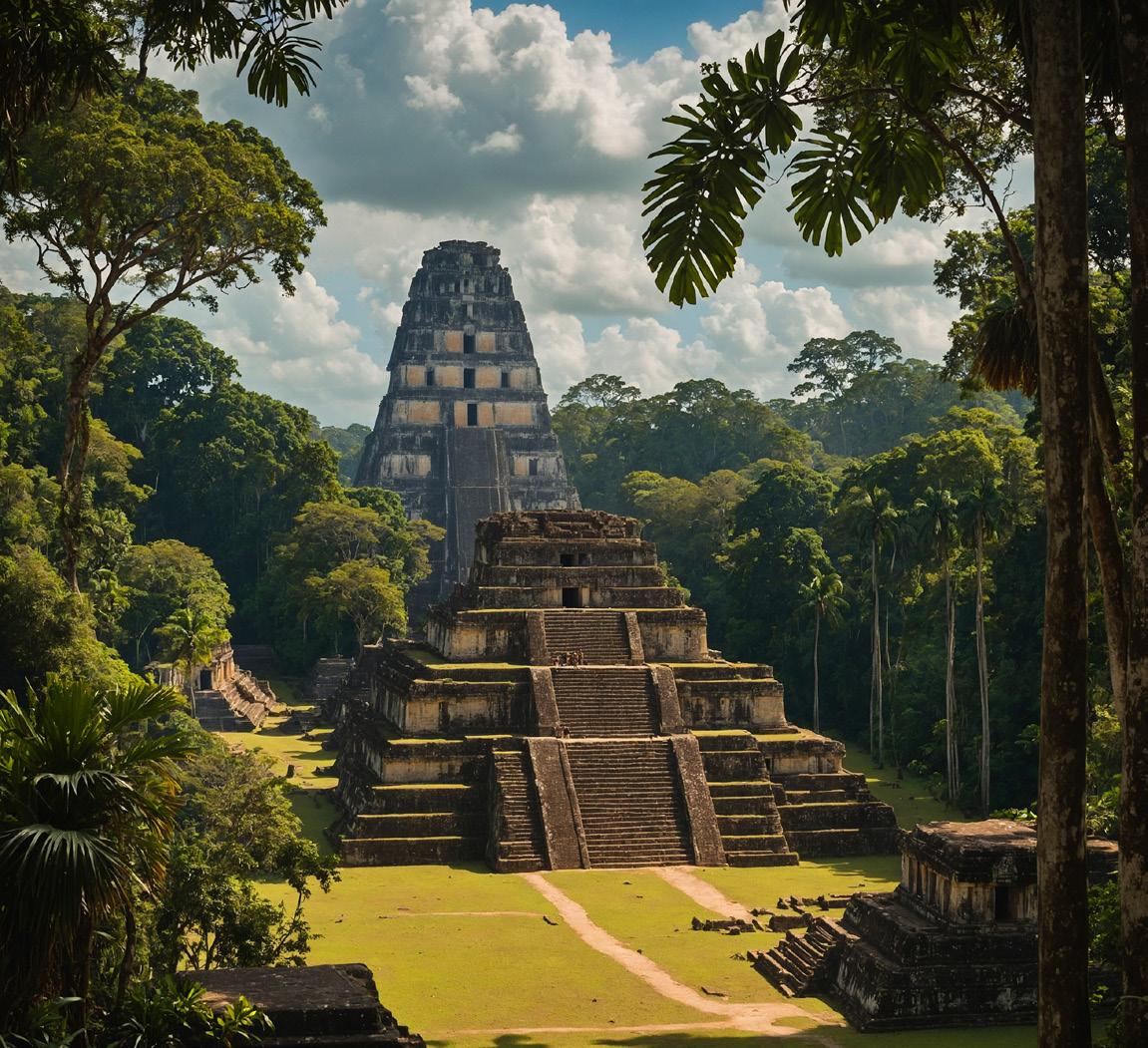
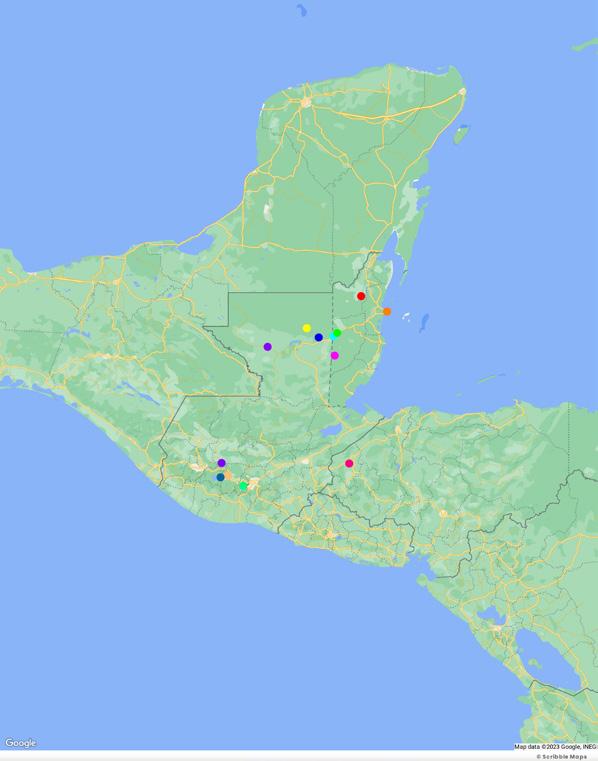
Much of Central America is still covered in lush rainforests as it would have been in most of the Maya period. This makes it easier to imagine the lives of these fascinating people as we venture through the jungle, listening out for the roar of howler monkeys high in the canopy and looking for the flash of brilliant colour that denotes macaws darting among the branches. Here, we are in a land of quetzal birds and jaguars, of volcanoes, lakes and waterfalls.
“ It had the usual Andante ingredientsexcellent sites, a knowledgeable and inspiring expert, interesting and special hotels and smooth organisation ”
Explore the beguiling city of Antigua, Guatemala’s candy-coloured capital and a UNESCO World Heritage Site. Here, we receive an introduction to the region – in a city renowned for its Spanish colonial buildings, its vibrantly patterned textiles and dramatic backdrop of looming volcanoes. Today’s Antigua is the third incarnation of the city, established on this land in the 16th century after the first incarnation was uprooted by native uprisings, and the second devastated by volcanic mudflow. From markets to churches, with tales of ground-breaking earthquakes in between, learn all about Antigua’s colourful past. It a city made for walking with its cobbled streets arranged in grid pattern with the imposing Volcán de Agua to the south and the twin peaks of Volcán de Fuego and Acatenango to the west.
We discover some of the villages along the shores of Lake Atitlan high in the mountains of central Guatemala. Its spectacular setting and deep blue water have long been a draw for artists, writers and travellers. Aldous Huxley compared it to Lake Como but "… with the additional embellishment of several immense volcanoes. It is really too much of a good thing." Although ancient Maya civilisation perished, Maya culture persists in the quiet villages along the shoreline and in the mountains where old customs and costumes still prevail. During our time at Lake Atitlan we will be taking a boat trip.


Explore the extensive ruined city of Copán. Though initially discovered in 1570, the ruins of Copán were not excavated until the 19th century. They are now a designated UNESCO World Heritage Site and are much admired for their Hieroglyphic Stairway, upon which the longest inscribed Maya text can still be viewed. We wander the stone ruins, viewing ancient tombs, the grand Monument Plaza, and the magnificent ball court, where an early precursor to the modern game of basketball was played –a site of great cultural and spiritual significance.
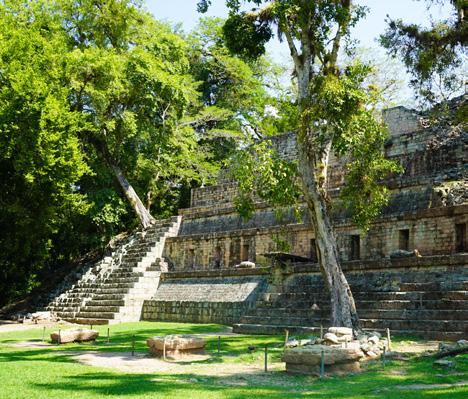
The mighty Tikal, an incomparable Maya metropolis, was occupied continuously from 800 BC to AD 900. Tikal National Park is an enormous site – its central section alone contains over 3,000 buildings – and still only a small portion has been excavated. This includes steep pyramids, palaces, ball courts, huge plazas, temples, shrines and paved causeways. The finds from these vast excavations are houses in the site museum which offers plenty of extra historical and archaeological insight that will bring this ancient civilisation vividly to life.
We visit Cahal Pech, which consists of 34 classical- era structures, including palaces, temples and plazas, situated around a central acropolis.
Once home to an elite family, it is one of the oldest Mayan sites in Western Belize and offers a fascinating window into the past, complete with panoramic views over the Belize River Valley.
We venture deep into the forests to the Vacau Plateau, where the impressive Maya city of Caracol invites more ancient exploration. Caracol is the biggest Maya city in Belize and contains some impressive structures dominated by the ‘Canaa’ or ‘Sky Palace’, a pyramid some 46 metres in height. The settlement area of ‘greater’ Caracol is thought to have covered some 88 km2 and around 35,000 constructions may have been occupied within this area when the city was at its peak in the Late Classic period between 650 – 700 AD.
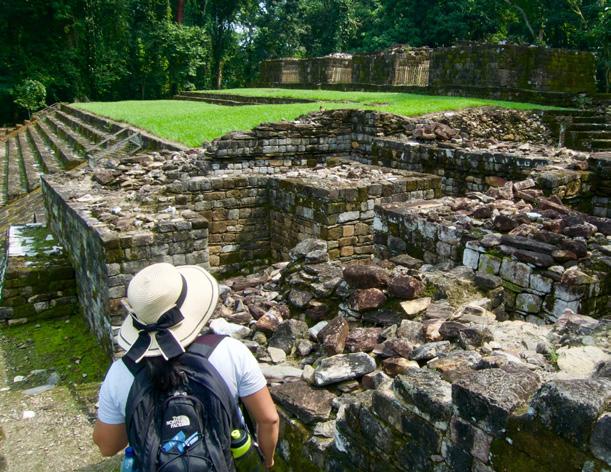
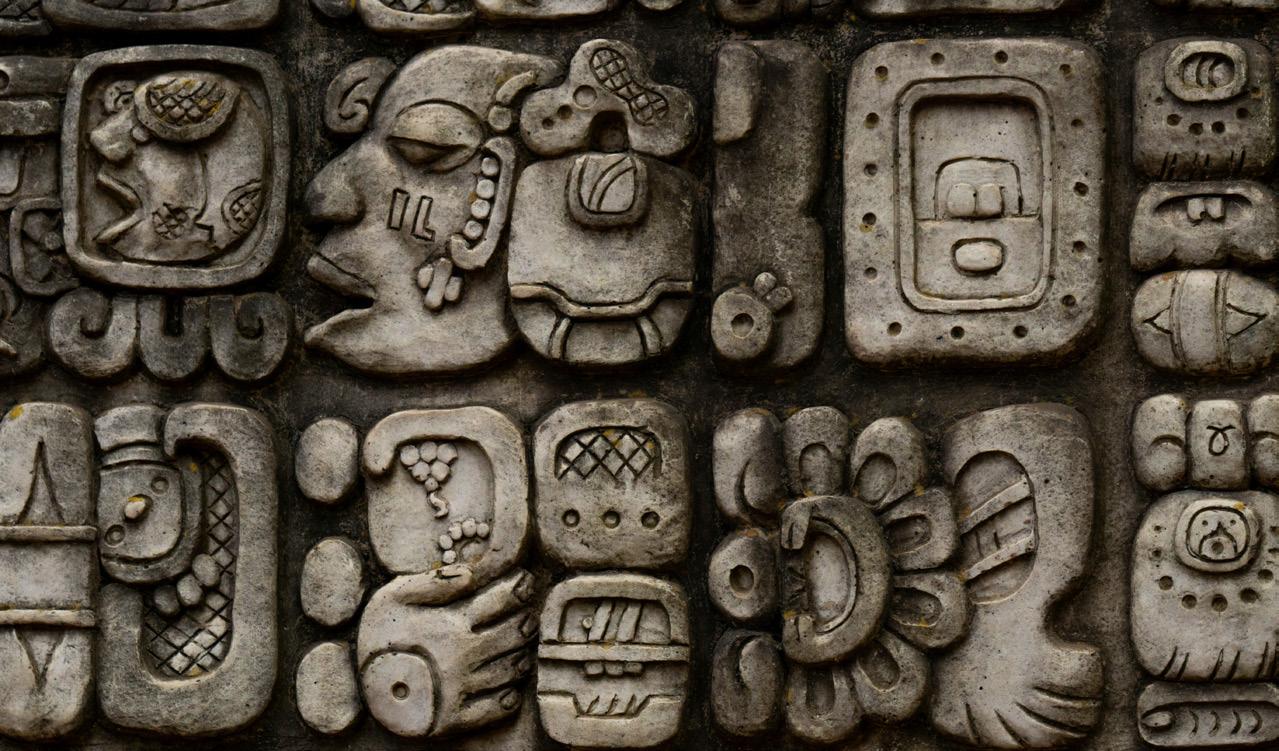

Wander the remote jungle remains of Lamanai, which spread along the shores of the New River lagoon. It is unique in being the longest lasting of all Maya cities and there was a settlement here on the banks of the New River lagoon by 1500 BC. Never abandoned, there were still Maya here to introduce themselves to the Spaniards when they arrived about 1545. In the 9th century, when everywhere else in the Maya world was falling apart, Lamanai was still prospering, its temples maintained, new residential areas built. Highlights here include the extraordinary Mask Temple, decorated by a 13-foot-high stone mask of a Maya king, and the High Temple.
itinerary Day 1 Antigua Guatemala
2 Antigua Guatemala
3 Antigua Guatemala – Iximche - Lake Atitlan
4 Lake Atitlan
Day 5 Lake Atitlan – Chichicastenango –Antigua Guatemala
Day 6 Antigua – Copán, Honduras
Day 7 Copán
Day 8 Copán - Petén
Day 9 Tikal
Day 10 Tikal
Day 11 Petén - Yaxhá - Topoxte - Belize
Day 12 Xunantunich & Cahal Pech
Day 13 Caracol
Day 14 San Ignacio - Lamanai Day 15 Lamanai
16 Lamanai - Belize City
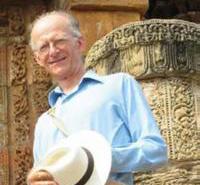
YOUR EXPERT GUIDE LECTURERDR NICHOLAS JAMES
Author of “Aztecs & Maya”, Nicholas has worked on the history, archaeology and anthropology of the indigenous peoples of the Americas for more than 40 years. He graduated from Oxford and now teaches at Cambridge.
Hotel Camino Real Antigua, Hotel Atitlan, Hotel Marina Copán, Hotel Casona del Lago, San Ignacio Resort Hotel & Lamanai Outpost Lodge or similar
more detail at andantetravels.com/aghb

Discover some of the world’s most enigmatic rock art


Santiago, Chile’s capital since the colonial era, offers a wonderful mix of old and new. Sprawling skyscrapers contrast with historic pastel-coloured buildings, world-famous museums meet beloved local diners and the Andes provide a beautiful backdrop to bustling city life. On foot is the perfect way to take in the culture and local atmosphere as we discover its many parks, winding streets and eclectic buildings, admiring the fusion of colonial, Art Deco, and Neo-Gothic styles.
One highlight is the Museo de Arte Precolombino, which houses an incredible collection of Latin American antiquities. Begun by Chilean architect and antiques fanatic Sergio Larraían García-Moreno, it displays many interesting artefacts that have been selected specifically for their aesthetic qualities, such as Mapuche funeral carvings and an entire room of beautiful prehistoric textiles. Another must-see is the Museo de Arqueologico e Historia Francisco Fonck, which boasts a rich collection of wooden carvings, striking displays of archaeological material from other parts of Chile.
Arica awaits, the seaside port and town in northern Chile, just a few miles south of the Peruvian border. Here, we explore the culture and history of the Chinchorro people, beginning with a visit to Colon 10, a burial ground of the Chinchorro, found in 2008. Interestingly, the museum was built directly over the burial ground, so some of the excavated skeletons have remained in situ. We also visit the San Miguel Archaeological Museum, home to the famous Chinchorro Mummies, preserved for several millennia by the dry heat of the desert. Modern analysis of the mummies has revealed them to be semi-nomadic people subsisting on the sea. Astonishingly, the oldest body predates the Egyptian mummies by some 3,000 years. We also cross the stark oasis of the Azapa Valley to view the spectacular rock art still visible on the hillsides — a vivid assortment of human figures and animals.
Atacama Desert, the driest desert in the world according to studies by NASA. Parts of this region have never received even one drop of rain. As part of our journey through Chile, we stop to explore El Gigante del Atacama, the world’s largest prehistoric depiction of a human. We also visit the geoglyphs at Ariquilda, Tiliviche and Chiza. The sprawling human and llama geoglyphs here are thought to have been created as a guide to caravans descending from the mountains to the coast.
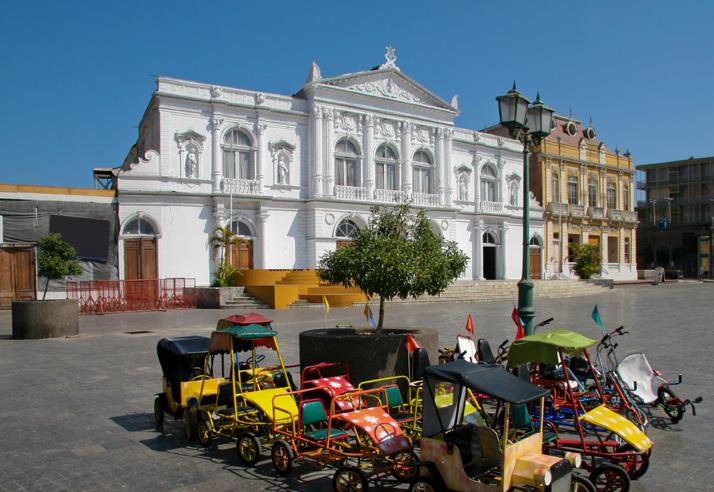
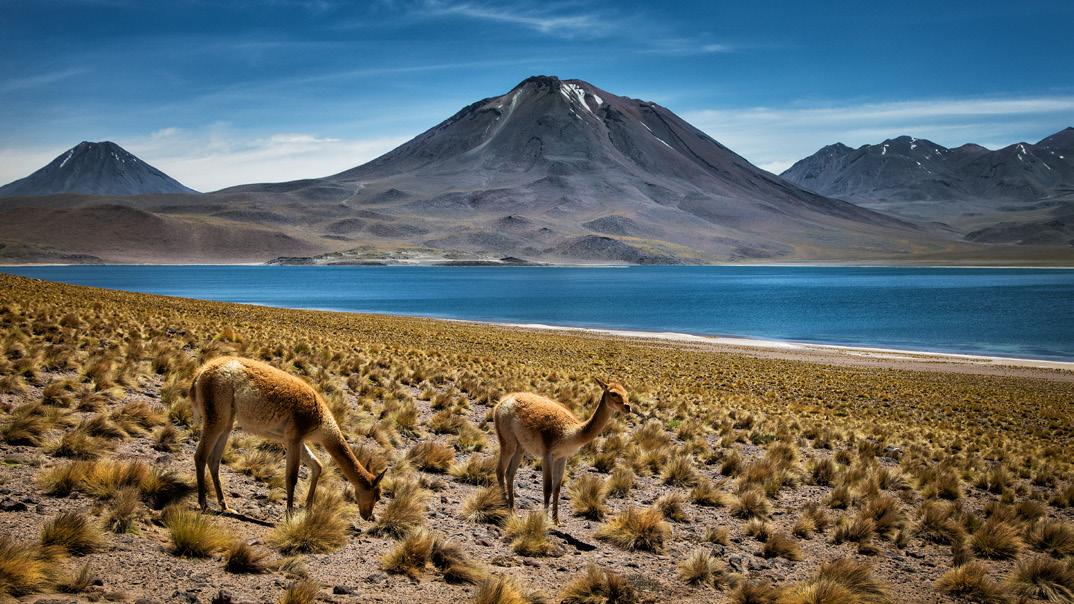
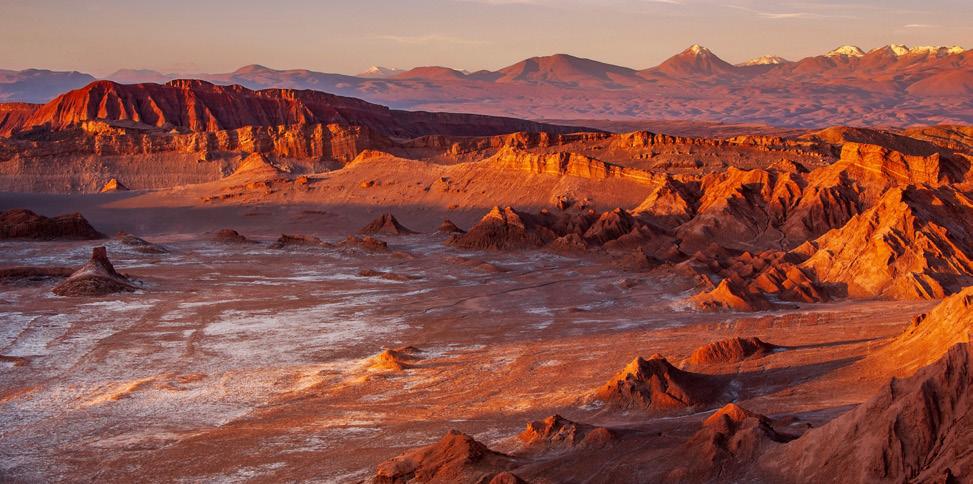
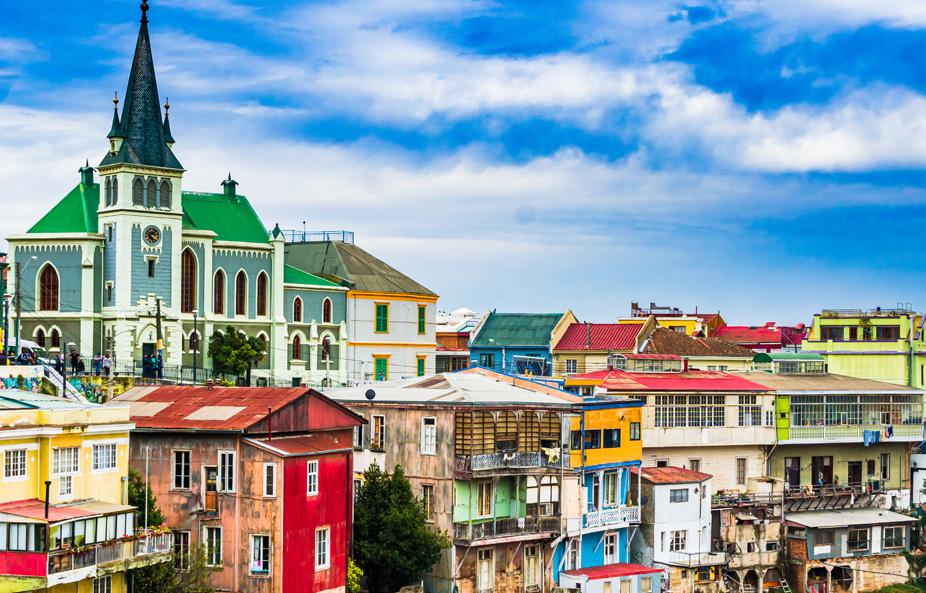
The journey to Iquique is broken up at the famous Cerros Pintados (painted hills) to view geoglyphs scattered for miles along the barren hillsides. More than 450 figures have been discovered here, the largest collection of its kind in South America. After our long journey, we take time to relax once in Iquique, a spectacular port city and one of the country’s premier beach resorts thanks to its position along the golden coastline. We admire the cityscape from a different perspective with a boat trip from the harbour into the Pacific, looking out for pelicans, sea-lions and endangered Humboldt penguins. We also include an atmospheric tour of the ‘ghost town’ of Humberstone, a former saltpetre mining town that was abandoned in 1960. The fertiliser sodium nitrate produced here transformed agriculture in North and South America, and Europe, generating great wealth for Chile, and the area has since been declared a UNESCO World Heritage Site.
San Pedro de Atacama is an oasis village surrounded by spectacular volcanic scenery – and one of Chile’s most beloved destinations. Our morning is spent among the amazing lunar landscapes of the Valle de la Luna, a colourful and textured valley that contains unusual wind-carved formations and dry lakes that gleam with salt. The afternoon is free to spend how you wish, either relaxing at the hotel, exploring Pedro de Atacama or joining an optional excursion which can be arranged through our Local Guide. One of the most popular is to the extraordinary Atacama Salt Flat, located about 60 kilometers south of San Pedro.
“ This was an absolutely wonderful holiday, with a very good balance between time spent on organised visits to archaeological sites and museums and free time. I am still thinking about all that we saw and learned, and feeling refreshed and inspired by the time we spent in Chile. Really, one of the best holidays I have had in a long time.
THANK YOU, ANDANTE! ”
Easter Island, one of the most isolated locations on the planet, forms the second part of our adventure. A land of mysterious monumental statues called moai, unique landscapes and a rich history, there is so much to discover. Our first full day on Easter Island begins with a trip to our first moai at Ahu Tahai, where these monolithic human figures stand – one with its giant coral eyes replaced. Three ceremonial platforms remain on this site, which were restored by the late American archaeologist, Dr William Mulloy, who is buried here alongside his wife. We continue on to the nearby Museo Antropologico Sebastian Englert to learn the story behind the moai and their discoverers. Here we see the only female moai to have been discovered, as well as an original moai eye.
Another highlight is the quarry at Rano Raraku, where many unfinished moai are still standing in situ. The site was in use until the 18th century, supplying stone for around 97% of the island’s moai over a time frame of approximately 500 years. The biggest moai in existence lies here incomplete and measures a staggering 21.6 metres from end to end. Following this we visit the longest line of standing statues at Tongariki, the largest Ahu on the island, where we find the world’s heaviest re-erected moai, weighing in at an almost inconceivable 86 tonnes. The rock carvings at Papa Vaka await too, where we see marine petroglyphs carved into the basalt, including a remarkable depiction of a squid.
The south coast is home to even more moai sites, contrasting with Anakena Beach, renowned for its white coral sands. There is Ahu Vaihu, where the moai lie face down with broken necks; Akahanga, an unrestored platform near which the island’s first king is said to be buried; Hanga Tetenga, where tumbled statues rest amidst scattered rocks; Te Pito te Kura, the site of a bizarre magnetic stone as well as the largest moai to be transported from Rano Raraku; and, lastly, but by no means least, the detailed carved figures of the royal platform of Ahu Nau Nau.

YOUR EXPERT GUIDE LECTURERDR PAUL BAHN
The world’s leading archaeologist on prehistoric rock art, Paul is one of our best-known guide lecturers.
Dr Paul Bahn is the leading expert on prehistoric rock art worldwide, and is certainly one of our best-known archaeologists. Paul led the team which discovered the first Ice Age cave art in Britain in 2003. He is not only a leading academic but a great exponent of popular and accessible archaeology, and he has been leading tours for Andante Travels since 2000, inspiring and enthusing our travellers in the famous caves of France and Spain, in open-air rock shelters in Portugal, and in Chile and Easter Island. His most recent publication, Images of the Ice Age, was awarded Book of the Year in the Current Archaeology Awards.

Easter Island petroglyph
Day-by-day itinerary
The restored moai in the harbour of Hanga Piko and Ana Kai Tangata (‘cannibal cave’), situated directly on the seafront are sights to behold too, as well as Rano Kau, a wide volcano within which lies a crater lake. Here we visit the Orongo ceremonial village, perched magnificently on the crater’s edge, beside a sheer 300-metre cliff. Other stops include the ruined platforms of Vinapu, the lava cave at Te Pahu, the inland platform of Ahu Akivi with its seven identical statues seemingly placed to mark both spring and autumn equinoxes plus Ahu Huri a Urenga. Finally, we visit the quarry at Puna Pau, an extinct volcano and source of the huge red cylindrical stone top-knots seen on the heads of many maoi. A climb to the sides of the crater rewards us with wonderful views of Hanga Roa.
Day 1 Santiago
Day 2 Santiago – Calama – San Pedro de Atacama
Day 3 San Pedro de Atacama
Day 4 San Pedro de Atacama – Iquique
Day 5 Iquique
Day 6 Iquique – Arica
Day 7 Arica
Day 8 Santiago - Valparaiso
Day 9 Santiago – Easter Island
Day 10 Easter Island
Day 11 Rano Raraku & Papa Vaka
Day 12 Akahanga & Anakena Beach
Day 13 Rano Kau, Vinapu & Puna Pau
Day 14 Easter Island – Santiago
Day 15 Santiago
Your comprehensive expert guided tour includes
20th Nov - 4th Dec
15 Days
All local transport
14 breakfasts, 13 lunches & 13 dinners
Accommodation
Hotel Magnolia, Hotel Antay, Gavina Sens & Conference Centre, Hotel Poblado Kimal, Holiday Inn Santiago & Hotel O'tai or similar
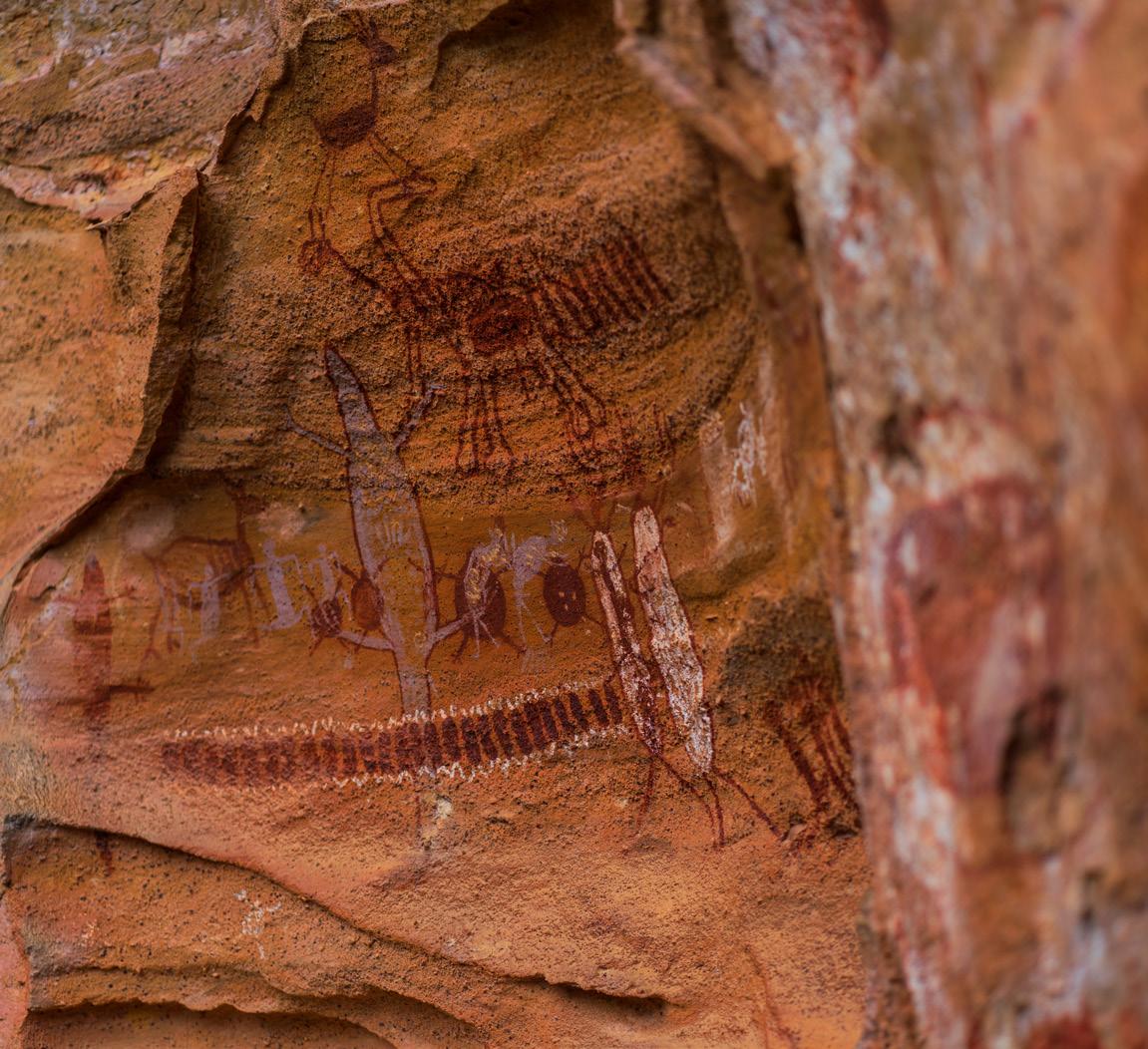
14 days from $14,697pp
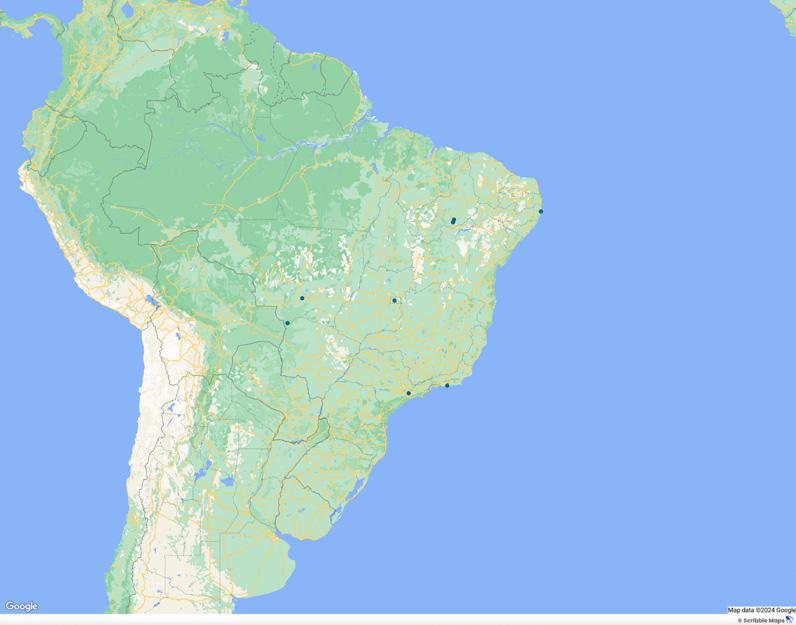
In a remote corner of northeast Brazil, amongst the sandstone cliffs, rocky canyons and deep valleys of the Serra da Capivara, there are hundreds of prehistoric sites. Pedra Furada meaning ‘perforated rock’ was the first site to be excavated here by Brazilian archaeologist, Niéde Guidon and her findings caused uproar, challenging the Clovis theory that Homo sapiens arrived in the Americas 12,000 years ago. According to UNESCO, in light of these findings, the region represents one of the most significant archaeological sites in the world, and an outstanding testimony to one of the oldest human communities in South America.
Led by Dr Paul Bahn, this is a very special tour indeed, taking us to prehistoric sites seldom seen by foreign travellers. We will meet site archaeologists who will bring us up to date on the latest developments connected with these amazing discoveries and travel into the park by off road vehicle to see as much of the area as possible. We may catch sight of some of the animals depicted so beautifully in the rock art–armadillos, anteaters, ocelots, guans, agoutis, lizards, red deer, wild pigs, as well as a variety of birdlife.
After our brush with prehistory, we will journey from one remote region to another flying south and travelling into the Pantanal, one of the most biologically rich environments on the planet, saturated with wildlife and an absolute gem for photographers and naturalists alike. Here we search for jaguar, giant otter, anteaters, capybara, hyacinth macaw.
Rio de Janeiro, often simply referred to as Rio, is one of the most vibrant and iconic cities in Brazil. Known for its stunning natural landscapes, Rio boasts famous beaches such as Copacabana and Ipanema, as well as the impressive Sugarloaf Mountain and the Christ the Redeemer statue, which overlooks the city from Corcovado Mountain.
The city is also renowned for its lively culture, particularly its annual Carnival festival, which features elaborate parades, samba music, and vibrant costumes. Rio's diverse neighbourhoods offer a rich mix of experiences, from the historic charm of Santa Teresa to the bustling nightlife of Lapa.
On our tour, we will explore two of its museums: the Museu Historico housed in a former arsenal and by contrast the ultramodern Museum of Tomorrow. We take a stroll in the Jardim Botanico. Along with its stately rows of palms, ornamental ponds and orchid greenhouses, it teems with over 9,000 different plant species and some of the most endangered flora in Brazil. Rio, sheltering between two mountains can be viewed from both and this evening we view it from Corcovado Mountain, home to the iconic art deco monument of Christ the Redeemer.
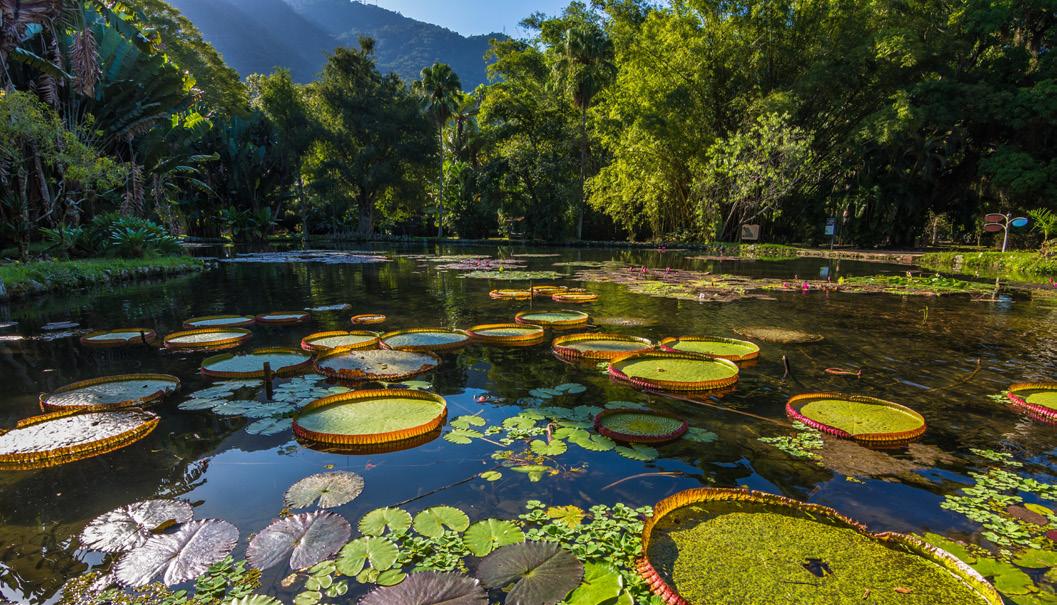
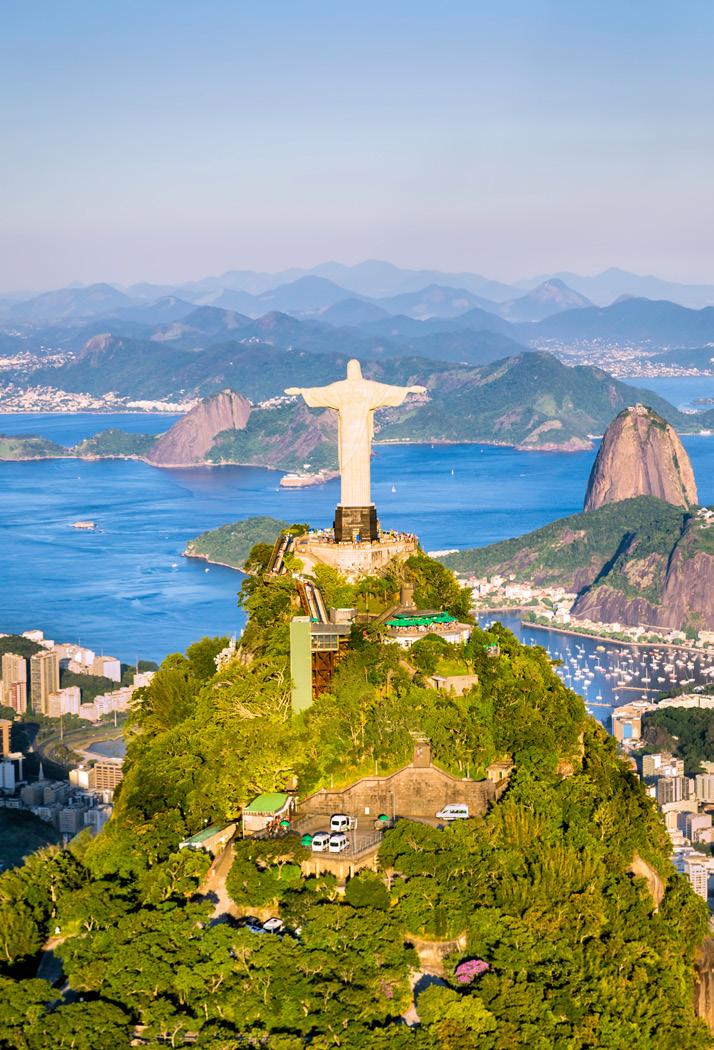
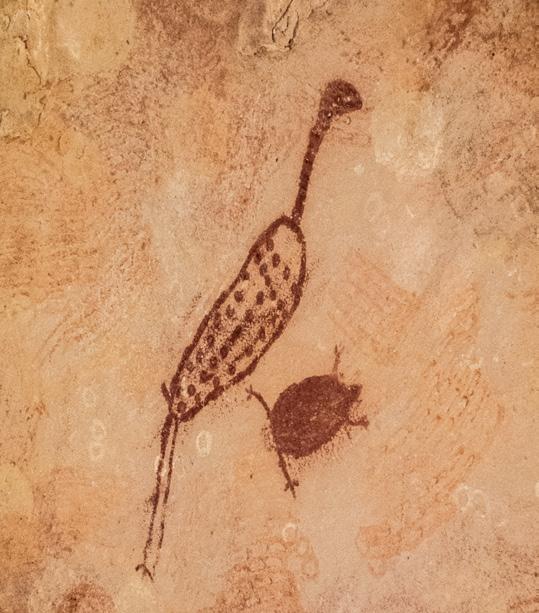

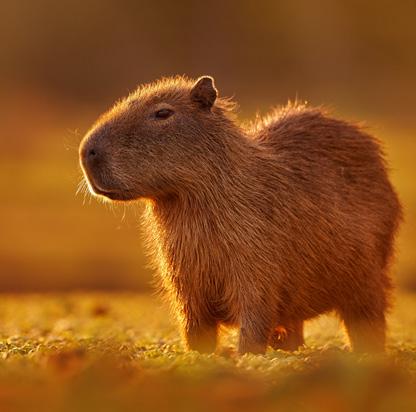
Serra da Capivara is a stunning national park located in the northeastern region of Brazil, in the state of Piauí. Renowned for its rich archaeological significance, the park is home to some of the oldest rock art in the Americas, with paintings that date back to 25,000 years. These ancient artworks provide a fascinating glimpse into early human life and culture in the region.
The park spans over 129,140 hectares and features a diverse landscape that includes dramatic cliffs, deep canyons and dense forests. This varied terrain supports a wide range of flora and fauna, making it a paradise for nature enthusiasts and wildlife observers. Serra da Capivara is also a UNESCO World Heritage site, recognised for its outstanding universal value. It offers a unique opportunity to connect with the prehistoric past while enjoying the natural beauty and biodiversity of the area.
We spend five days exploring many extraordinary sites of the Serra da Capivara including visits to the site of Boqueirão Pedra Furada, a huge geological structure discovered by Niéde Guidon. An extremely important site surprising in the unique chronological range it covers: a stratigraphy of, at least 60,000 years of human occupation, in addition to traces of animals such as sabre-toothed tigers and giant sloths.
The rock art circuit also includes the sites of Toca do Sítio do Meio and Toca da Fumaça. We vvisit numerous sites including Toca do Vento, Toca do Mulungu, Toca do Caboclo da Serra Branca, Toca da Extrema, Toca do João Arsena, Toca do Veado, Toca Pingo de Boi and Sítio Andorinhas.
“ The management of the holiday, on a day-to-day basis, was top quality. We wanted for very little and found it great fun to be with friendly, like-minded people ”
Founded by gold prospectors in the 18th century, Cuiabá sits on the Cuiabá River, a tributary of the mighty Paraguay and the gateway to the northern Pantanal, the world’s largest freshwater wetland.
The wetlands are comprised of a patchwork of different ecosystems – dense woodland, open savannah and rainforest.
On our tour, we enjoy a mix of safari drives and gentle walks in easy terrain. Our time is spent hunting for wildlife, walking from the lodge or adventuring out by our vehicle. There is no shortage of wildlife viewing opportunities here from the brightly coloured macaws which dart amongst the tree canopy to the comical capybara that frequent the wetlands. Other wildlife highlights include giant anteaters, giant otters, tapirs and jabiru storks and a vast range of other tropical birds.
We enjoy a sunrise safari, our best chance of seeing the giant anteater as it searches for food before we transfer to our houseboat permanently moored on the Piquiri riverbank.
The Pantanal is best known for its incredible jaguar viewing. This is best achieved by manoeuvrable boats in the northern part of the wetlands, where the cats have the habit of hunting along the riverbanks.
Cuiabá, the capital of the Brazilian state of Mato Grosso, is a vibrant city that attracts visitors for several compelling reasons. One of the main draws is its proximity to some of Brazil's most stunning natural attractions. Located near the geographical centre of South America, Cuiabá serves as a gateway to the Pantanal, the world's largest tropical wetland area, renowned for its rich biodiversity and unique wildlife experiences.
Additionally, Cuiabá is a starting point for exploring the Chapada dos Guimarães National Park, which offers breathtaking landscapes, waterfalls and hiking trails. The city itself is steeped in history and culture, with colonial architecture, vibrant markets, and a lively culinary scene that showcases the flavours of the region. Whether you're an adventure seeker, a nature lover, or a cultural enthusiast, Cuiabá has something to offer for everyone. Jaguar

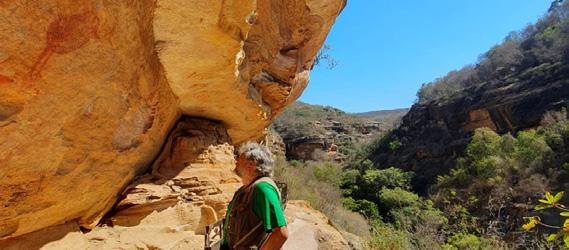
Dr Paul Bahn is the leading expert on prehistoric rock art worldwide and is certainly one of our best-known archaeologists. Paul led the team which discovered the first Ice Age cave art in Britain in 2003. He is not only a leading academic but a great exponent of popular and accessible archaeology, and he has been leading tours for Andante Travels since 2000, inspiring and enthusing our travellers in the famous caves of France and Spain, in open-air rock shelters in Portugal, Chile and Easter Island. His most recent publication, Images of the Ice Age, was awarded Book of the Year in the Current Archaeology Awards.
Mexico - The Maya
An in-depth tour from Mexico City to the Yucatán peninsula
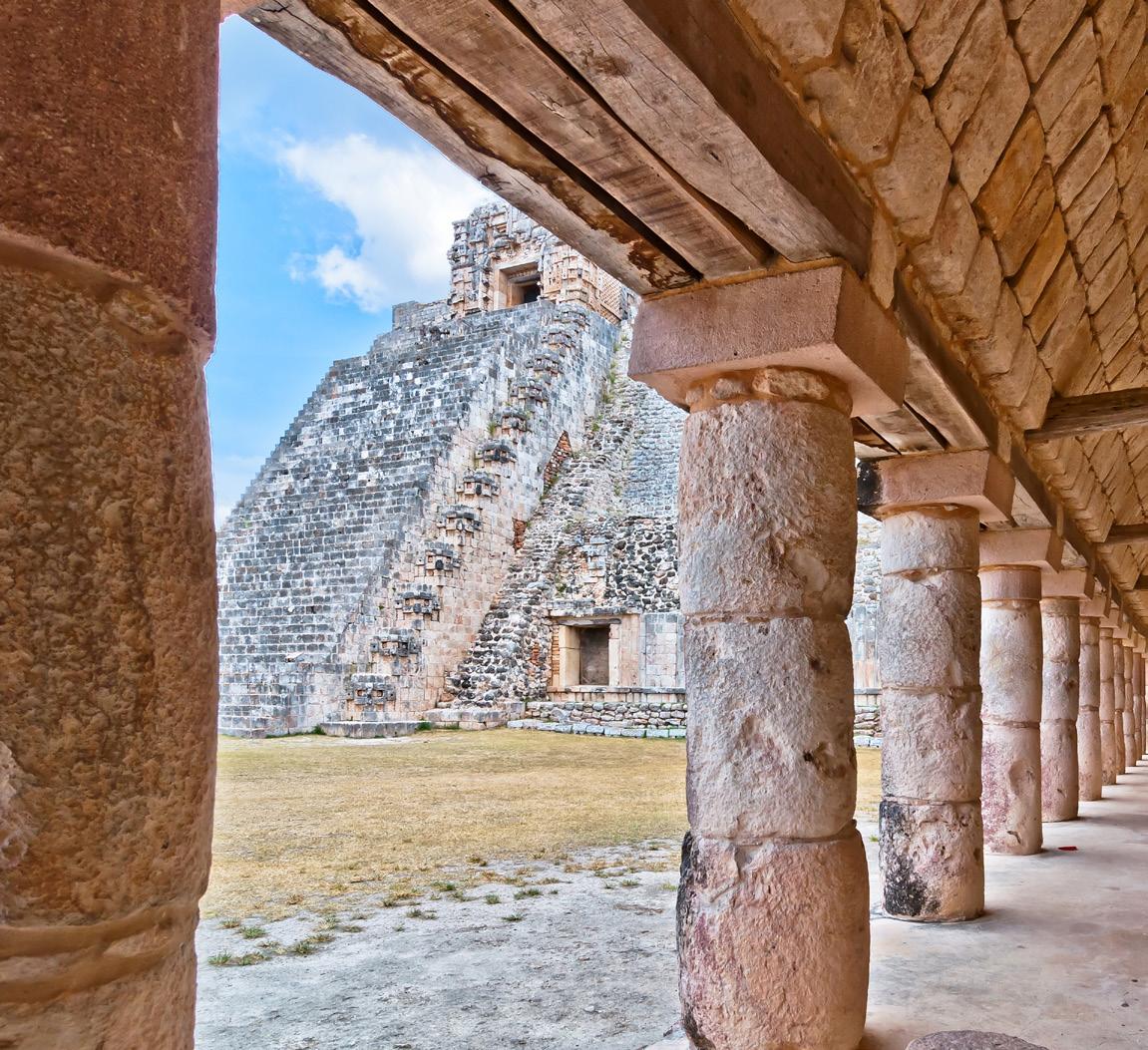
15 days from $9,374pp

Of all Mesoamerican civilisations, the Maya have enjoyed the most enduring hold on the popular imagination. For a long time, their jungle-clad ruins remained intriguing, yet shrouded by mystery. However, recent progress in the decipherment of Maya writing has unlocked many of their secrets, revealing a society as complex and fascinating as their art and architecture had previously suggested.
The Maya civilization was a Mesoamerican culture known for its hieroglyphic script, the only known fully developed writing system of the pre-Columbian Americas. Flourishing between AD 250 and 900, the Maya developed a sophisticated culture with advancements in mathematics, astronomy, art, and architecture. They built impressive cities with monumental pyramids, palaces, and observatories, many of which remain as ruins today in Mexico, Guatemala, Belize, Honduras, and El Salvador.
The Maya were also skilled farmers, creating intricate agricultural systems to support large populations. They engaged in extensive trade networks, connecting with other Mesoamerican cultures. Their religious practices included complex rituals and ceremonies, often conducted by a class of elite priests. Despite their achievements, the Maya civilization experienced a mysterious decline starting around the 9th century, leading to the abandonment of many cities. However, the Maya people and their descendants continue to live in Central America, preserving many aspects of their rich cultural heritage.
This is one of Andante’s most adventurous trips, starting with the superb museums of Mexico City, travelling via the uplands of Chiapas, along the great river of Usumacinta, before driving up the Yucatan peninsula. This is a thrilling journey through the rich and colourful landscapes of Mexico!
Mexico City, the vibrant capital of Mexico, is a sprawling metropolis that seamlessly blends rich history with modern urban life. Known for its diverse cultural heritage, the city boasts a plethora of museums, historic landmarks, and vibrant neighbourhoods. Visitors can explore the ancient ruins of Teotihuacan, wander through the bustling markets of Coyoacán or admire the stunning architecture of the Palacio de Bellas Artes.
With its dynamic food scene, ranging from street tacos to gourmet dining and a lively arts and music culture, Mexico City offers an unforgettable experience.
We will experience much this fantastic city has to offer, including a trip to the remains of the Templo Mayor, once the sacred heart of Tenochtitlan, the Aztec capital, combined with a visit to the excellent museum. Our tour will take us to the National Museum of Anthropology, one of the finest museums in the world, with collections spanning every era of Mexico’s richly textured past.
San Cristóbal de Las Casas, nestled in the highlands of Chiapas, Mexico, is a charming colonial town brimming with history and culture. As you stroll through its cobblestone streets, you'll be captivated by the colourful facades of the well-preserved buildings, each telling a story of the town's rich past.
There is much to explore, including Tuxtla Gutiérrez, on the edge of the beautiful Chiapas Highlands and Chiapa de Corzo, a handsome colonial town, the great centre of traditional Maya culture. We also have the opportunity to look at the products of the many hundreds of local Maya weavers who come here from nearby villages.
There is much to see, including a visit to Chamula, one of the most fiercely independent of all Maya towns. Here, famously, the local community have been largely left to run their own affairs. The use of the church of San Juan is a symbol of this. The Catholic clergy are absent most of the year and instead traditional Maya priests or shamans minister to the local population. On most days the interior of the church is packed with chanting priests and their clients.


The ruins of Palenque are beautifully positioned on the lower slopes of a range of jungle-clad hills, with magnificent views across the floodplain of the Usumacinta River. The city possesses art and architecture of remarkable quality, most famously in the well preserved ‘Palace’ complex and the ‘Temple of the Inscriptions’, where Palenque’s greatest king, Pacal, lies buried in a massive sarcophagus. Abundant hieroglyphic texts here have been crucial in piecing together the story of Palenque’s rulers, a dynasty that lasted from c. 430 to 800 AD.
The famous Maya site of Bonampak is best known for the remarkable preservation of its vividly painted murals. From Bonampak we continue to the Usumacinta River and a journey by motor launch downriver to the jungle site of Yaxchilán, constructed within a horseshoe bend in the river. It is a remote and atmospheric place, many of the buildings well-preserved though devoid of some of its famous carved lintels. A number of these were removed by the British explorer Alfred Maudslay in the 1880s and are now to be seen in the ‘Mexican Gallery’ of the British Museum.
Campeche, a coastal city in Mexico, is renowned for its rich history, colonial architecture, and vibrant culture. Nestled on the western side of the Yucatán Peninsula, Campeche offers visitors a unique blend of historical landmarks and modern attractions. The city is a UNESCO World Heritage site, boasting well-preserved fortifications, colorful facades, and charming cobblestone streets. Visitors can explore the impressive city walls, visit the grand cathedral, and stroll through the picturesque central plaza. Campeche is also known for its delicious cuisine, featuring fresh seafood and traditional Yucatecan dishes.
Uxmal is an ancient Mayan city located in the Yucatán Peninsula of Mexico. Known for its impressive architecture and intricate carvings, Uxmal is a UNESCO World Heritage Site that offers a glimpse into the rich history and culture of the Maya civilization.
The city is famous for its Pyramid of the Magician, the Governor's Palace and the Nunnery Quadrangle, each showcasing the advanced engineering and artistic skills of the Maya people.
The Pyramid of the Magician was built in five separate stages. But the city’s two major glories are the so-called ‘Nunnery’ quadrangle, made up of four rectangular range structures with multiple doorways around a central courtyard, and the magnificent House of the Governor, constructed on a broad platform and at a different angle to other structures, facing east towards the most southerly rising point of Venus as Morning Star. A recently deciphered inscription above the central doorway confirms this purposeful astronomical orientation.


Chichén Itzá offers a fascinating glimpse into the advanced engineering, astronomy and culture of the Maya people. This ancient city was a major focal point in the northern Maya lowlands from the Late Classic through the Terminal Classic periods and even into the early portion of the Postclassic period (approximately 600 AD to 1200 AD). The site is renowned for its architectural marvels, including the iconic pyramid known as El Castillo (the Temple of Kukulcán), the Great Ball Court, and the Temple of the Warriors.
Explore the immense Ball Court and the ‘Castillo’ or Temple Pyramid at the heart of an enormous plaza and follow the great stone causeway to the sacred ‘Cenote’ or well. Into this natural sinkhole in the limestone, the Maya cast jades, precious metalwork and sacrificial victims which lay undiscovered until the early 20th century, even though the site was known and marvelled at by early Spanish visitors, including Diego de Landa.
Visit the city of Ek Balam, a lesser-known site, but where major discoveries have been made over the last decade or so. These demonstrate that Ek Balam was a major power in northern Yucatan in the Maya Classic period and may have had close ties to Chichén Itza. Here one can climb the steps of the largest pyramid for a marvellous view of the surrounding jungle.
“ Usual great Andante experience. Excellent guides and driver and companiable group of people. God variety of food (if the portions were rather on the large side!) odd minor hitch, not of your making, all added to the fun ”
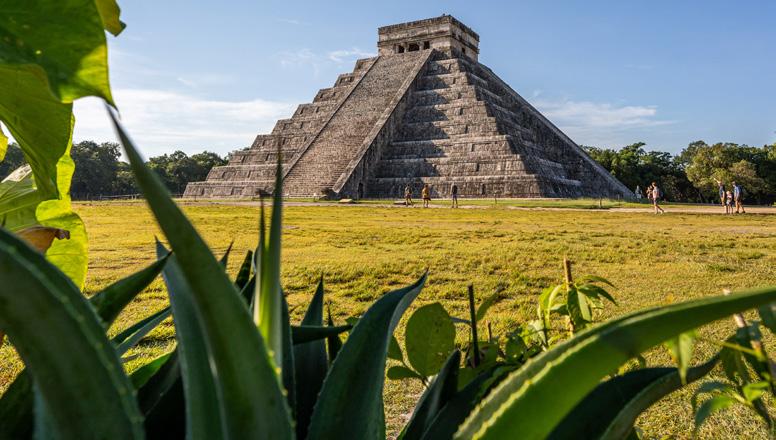

Dr. Elizabeth Baquedano is a specialist in the Archaeology of Mesoamerica, and a Senior Honorary Lecturer at the Institute of Archaeology, University College London, where she is the Co-ordinator of Aztec Archaeology and Ethnohistory. She also gives regular Gallery Talks at the British Museum and has led many tours to Mexico and Latin America. She has recently published a book through the University press of Colorado on Tezcatlipoca, one of the most important Aztec deities.
Your comprehensive expert guided tour includes Day-by-day itinerary
Day 1 Mexico City Day 2 Mexico City
Day 3 Mexico City
Day 4 Mexico City - San Cristóbal de las Casas
Day 5 San Cristóbal de las Casas
Day 6 Toniná - Palenque
Day 7 Palenque
Day 8 Bonampak - Yaxchilán
Day 9 Palenque - Campeche
Day 10 Campeche - Uxmal
Day 11 Uxmal - Mérida
Day 12 Mérida - Chichén Itzá Day 13 Chichén Itzá Day 14 Chichén Itzá - Tulum
15 Tulum - Cancun
local transport 14 breakfasts, 14 lunches & 14 dinners
Accommodation
Hampton Inn & Suites Mexico City, Hotel Casa Mexicana, Hotel Villa Mercedes, Hotel Plaza Campeche, Hotel Hacienda
Uxmal, Gamma Mérida El Castellano, Hotel Villas Arqueologicas Chichén Itzá & Hotel Dreams Tulum or similar
Find more detail at andantetravels.com/amex

